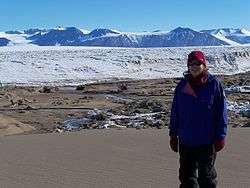Diane McKnight
Diane McKnight (born March 22, 1953) is a Professor of Civil, Environmental, and Architectural Engineering at the University of Colorado Boulder and a Fellow at the Institute of Arctic and Alpine Research (INSTAAR).[1] McKnight is a founding Principal Investigator of the National Science Foundation's Long-Term Ecological Research (LTER) program in the McMurdo Dry Valleys.[2]
Diane McKnight | |
|---|---|
 Diane McKnight in the McMurdo Dry Valleys | |
| Born | March 22, 1953 |
| Nationality | USA |
| Alma mater | Massachusetts Institute of Technology |
| Awards | Fellow, American Association for the Advancement of Science |
| Scientific career | |
| Fields | Limnology Biogeochemistry |
| Institutions | University of Colorado Boulder |
| Website | Diane McKnight at CU-Boulder |
Early life and education
McKnight received a BS in Mechanical Engineering (1975), MS in Civil Engineering (1978), and her PhD in Environmental Engineering in 1979, all from Massachusetts Institute of Technology.[3]
Career and impact
After completing her graduate studies, McKnight began working for the US Geological Survey (USGS) as a Research Scientist for the Water Resources Division.[4] As part of her work with USGS, she conducted research on lakes in the blast zone of Mount St. Helens in 1980.[5]
In 1996, McKnight transitioned to the University of Colorado – Boulder,[5] where she became one of the founding Principal Investigators of the McMurdo Dry Valleys Long Term Ecological Research Program[6] in Antarctica's McMurdo Dry Valleys. While continuing to conduct extensive research in Antarctica, she also conducts research in the Rocky Mountains,[7] where she develops interactions with state and local groups involved in mine drainage and watershed issues.[5] In total McKnight has authored or co-authored over 300 publications.[8]
McKnight has been nationally and internationally recognized for her “seminal”[9] and “visionary”[10] contributions to Antarctic science. Her contributions to major scientific institutions include service on several National Research Council Committees; service on the Water, Science and Technology Board and the Polar Research Board;[4] and tenure as President of the American Geophysical Union Biogeosciences section.[10] In 2015 she was awarded CU-Boulder's Distinguished Research Lectureship, which the university cites as being “among the highest honors bestowed by the faculty upon a faculty member at CU-Boulder”. McKnight also was founding editor of the Journal of Geophysical Research: Biogeosciences.[10]
Awards and honors
- John Dalton Medal, European Geosciences Union, 2015[9]
- Distinguished Research Lectureship, CU-Boulder, 2015[11]
- Hydrologic Science Award, American Geophysical Union, 2014[10]
- Elected Member, National Academy of Engineering, 2012[12]
- Fellow of the American Association for the Advancement of Science, 2009[13]
- Walter B. Langbein Lectureship, American Geophysical Union, 2005[14]
- Fellow, American Geophysical Union, 2004[15]
- Meritorious Service Award, U.S. Geological Survey, 1995[1]
Selected works
- McKnight, Diane M., et al. "Spectrofluorometric characterization of dissolved organic matter for indication of precursor organic material and aromaticity."Limnology and Oceanography 46.1 (2001): 38-48.
- Aiken, George R., et al. Humic substances in soil, sediment, and water: geochemistry, isolation and characterization. John Wiley & Sons, 1985.
- Tranvik, Lars J., et al. "Lakes and reservoirs as regulators of carbon cycling and climate." Limnology and Oceanography 54.6part2 (2009): 2298-2314.
References
- "Diane M. McKnight INSTAAR". instaar.colorado.edu. University of Colorado Boulder. Retrieved 2016-06-09.
- "Colorado high peaks losing glaciers as climate warms". nsf.gov. National Science Foundation. 2016. Retrieved 2016-06-09.
- "Civil, Environmental and Architectural Engineering". colorado.edu. University of Colorado Boulder. 2014-11-25. Retrieved 2016-06-09.
- Committee on US Army Corps of Engineers Water Resources Science, Engineering, and Planning (2012). Corps of Engineers Water Resources Infrastructure: Deterioration, Investment, or Divestment?. Washington, D.C: The National Academies Press.CS1 maint: multiple names: authors list (link)
- Pasquale, Cynthia (2012-06-21). "Five questions for Diane McKnight". connections.cu.edu. Retrieved 2016-06-09.
- "Principal Investigators". www.mcmlter.org. McMurdo Dry Valleys LTER. Retrieved 2016-06-09.
- Worl, Justin. "What The Colorado Waste Water Spill Tells Us About Mining Contamination". TIME.com. Retrieved 2016-06-09.
- "Diane Mcknight". mcmlter.org. McMurdo Dry Valleys LTER. Retrieved 2016-06-09.
- "John Dalton Medal". European Geosciences Union. 2015. Retrieved 2016-06-09.
- "McKnight Receives 2014 Hydrologic Sciences Award". honors.agu.org. American Geophysical Union. 2015-04-09. Retrieved 2016-06-09.
- "McKnight to deliver Distinguished Research Lecture". www.colorado.edu. University of Colorado Boulder. 2015. Retrieved 2016-06-09.
- "Professor Diane M. McKnight". www.nae.edu. National Academy of Engineering. 2012. Retrieved 2016-06-09.
- "Three CU-Boulder Faculty Members Elected AAAS Fellows for 2009". News Center. 2009-12-17. Retrieved 2016-06-09.
- "Langbein Lecture - Hydrology". hydrology.agu.org. American Geophysical Union. Retrieved 2016-06-09.
- "Union Fellows". honors.agu.org. American Geophysical Union. 2015-03-23. Retrieved 2016-06-09.
External links
- Diane McKnight's webpage
- Diane McKnight on Google scholar